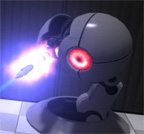npc_rocket_turret
Jump to navigation
Jump to search
 Note:In portal 2 authoring tools, its model in the editor is the error model.
Note:In portal 2 authoring tools, its model in the editor is the error model.
 Bug:If a rocket turret's target stops existing for any reason, it will seize up and not respond to SetTarget inputs until cycled off and back on. In standard usage (having the turret aim at a single player) this is rarely an issue, but it is something to be aware of when using rockets in multiplayer games or with NPC targets; players still exist while dead, so player deaths will not freeze the turret, but NPC deaths and players disconnecting will. [todo tested in ?]
Bug:If a rocket turret's target stops existing for any reason, it will seize up and not respond to SetTarget inputs until cycled off and back on. In standard usage (having the turret aim at a single player) this is rarely an issue, but it is something to be aware of when using rockets in multiplayer games or with NPC targets; players still exist while dead, so player deaths will not freeze the turret, but NPC deaths and players disconnecting will. [todo tested in ?]
 Note:In multiplayer, rocket turrets will not target anyone by default (immediately seizing up when turned on). The target must be set manually with SetTarget inputs.
Note:In multiplayer, rocket turrets will not target anyone by default (immediately seizing up when turned on). The target must be set manually with SetTarget inputs.
 Bug:
Bug: In Portal 2, rocket turrets have a number of bugs:
In Portal 2, rocket turrets have a number of bugs:
 Confirm:ai_relationship appears to not work?
Confirm:ai_relationship appears to not work?
npc_rocket_turret is a model entity available in ![]()
![]() Portal series. It is an Aperture Science Rocket Turret, which will track a single entity and fire rockets at it. In Portal 1 the target defaults to the SP player, but it can be overridden with SetTarget inputs.
Portal series. It is an Aperture Science Rocket Turret, which will track a single entity and fire rockets at it. In Portal 1 the target defaults to the SP player, but it can be overridden with SetTarget inputs.
- They will not target the SP player by default, so must be manually sent
SetTargetinputs to target the player like in multiplayer. - Rockets spawn stuck in place.
 Workaround:A trigger_push, env_physexplosion, or other similar entity will need to be used to propel them forward.
Workaround:A trigger_push, env_physexplosion, or other similar entity will need to be used to propel them forward.
- Rocket turrets' targeting lasers are bugged, displaying as nothing more than a blue glow on the end of the barrel.
 Workaround:The laser can be replicated with an env_beam parented to the barrel, though this will not be completely accurate as the original laser bends to hit targets to the side.
Workaround:The laser can be replicated with an env_beam parented to the barrel, though this will not be completely accurate as the original laser bends to hit targets to the side.
Keyvalues
- Name (targetname) <string>
- The name that other entities refer to this entity by, via Inputs/Outputs or other keyvalues (e.g.
parentnameortarget).
Also displayed in Hammer's 2D views and Entity Report. - See also: Generic Keyvalues, Inputs and Outputs available to all entities
- Rocket Speed (RocketSpeed) <float> (in all games since
 )
) - Speed the rocket will travel at.
 Bug:Doesn't work, as stated above. [todo tested in ?]
Bug:Doesn't work, as stated above. [todo tested in ?]
- Rocket Lifetime (RocketLifetime) <float> (in all games since
 )
) - The rocket will automatically detonate after this number of seconds.
- Tripwire Mode (TripwireMode) <boolean> (in all games since
 )
) - Makes this sentry aim in a fixed direction and not follow the target entity. When any entity crosses the beam (regardless of if they are the target), a rocket is fired instantly with no lock-on time. (Similar to prop_rocket_tripwire, but allows aiming in any direction)
- Tripwire Aim Target (TripwireAimTarget) <targetname> (in all games since
 )
) - In tripwire mode, the entity to aim at. If not specified, will aim down world angles.
Flags
- Disabled : [1]
Inputs
- SetTarget <string>
- Sets the target for the rocket turret to attack.
- Destroy
- Sets the rocket turret to its destroyed state, freezing it in place and emitting sparks.
Toggle:
- Toggle
- Toggle the enabled/disabled status of this entity.
EnableDisable:
- Enable / Disable
- Enable/disable this entity from performing its task. It might also disappear from view.
Outputs
- OnFoundTarget
- Fired when the rocket turret finds an unobstructed target.
- OnLostTarget
- Fired when turret's target is blocked.
- OnDeath
- Fired after this turret finishes its destroy think and begins its death think

